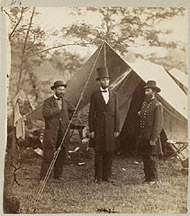The activities in this curriculum rely on three methods of visual analysis: description, reflection, and formal analysis. These methods provide a structure for viewing, analyzing, and writing about photographs that is consistent throughout the curriculum. For the purposes of explaining the methods of visual analysis, this section relies on Alexander Gardner's Lincoln on Battlefield of Antietam, Maryland, but the same methods can be applied to analyzing any image.

|
||
Description
The first step in visual analysis is description. Describing an image is a useful technique for looking closely at an image and absorbing its details. Descriptions should remain objective, discussing what can be seen without drawing conclusions about a photograph's meaning. For instance, when looking at Lincoln on Battlefield of Antietam, Maryland, it would be appropriate to say, "The tall man in the middle is wearing a black suit," but it would be inappropriate to say "The tall man in the middle is dressed as if going to a funeral." This sort of subjective comment should be reserved for the reflection section. A description can begin anywhere, but generally it is easiest to begin by discussing the subject matter. For example, a description of this image might begin with the basic statement, "In this black-and-white image, three men stand in front of a tent." Once you have stated the subject matter, simply elaborate on what you can see: "The man in the middle is the tallest and is posed with his hands down at his sides, wearing a formal black suit with a bowtie and a tall stovepipe hat. The man to the left is wearing a worn dark suit and a bowler hat. The man to the right is dressed in a military uniform with bright buttons and epaulets. The tent is pitched on a grassy clearing with trees in the background."
Reflection
This section should focus on the emotions and interpretations that an image evokes for the viewer. Different viewers will react to the same image in different ways, so there are no wrong responses. Knowing the historical context for an image can be very important for constructing reflective responses. For this image, it is important to know that the Battle of Antietam was one of the most bloody and brutal battles of the Civil War. Appropriate comments for this type of analysis include the following: "The tone of Lincoln on Battlefield of Antietam, Maryland seems very bleak. The somber facial expressions of the men, coupled with the barren grass and sparse trees give an overall impression of death and dying. There is also a sense of loneliness about the figure of President Lincoln. Although standing next to two men, he seems totally isolated. He is unresponsive to the camera; rather than making eye contact, he stares distantly off into space, increasing the sense of isolation."
Formal Analysis
After looking carefully at an image and considering its emotional and interpretive properties, formal analysis is the next step. Each lesson in this curriculum includes links to descriptions of the elements and principles of art, which can be used as a guide in your formal analysis. The "elements of art" are the building blocks for achieving the "principles of art." A very good place to start formal analysis is by deciding which elements are most strongly represented. In the Lincoln picture, the very distinct lines and geometric shapes are immediately apparent. Upon closer inspection, it is clear that these lines and shapes function to frame and to move the viewer's eye towards the central subject, President Lincoln. For instance, note the way that all of the lines in the image draw the eye toward the figure of the president. The tent forms an inverted "V" shape directly behind Lincoln, while the vertical tent post and tree trunk in the background further elongate Lincoln's already tall figure, clearly emphasizing Lincoln's figure in the composition. There are other strongly represented elements as well. Consider the use of contrast in this image: there is a stark contrast between the white of Lincoln's shirt and his black suit, which further draws our attention towards the president's face. There is also a sense of balance, with the figures standing to either side of the president in similar poses, like mirror images.